2024 Apiculture winter loss report
2024 honey bee colony winter mortality
Overwinter mortality for 2023–2024 for commercial beekeepers operating in Ontario was estimated to be 50%, up from the 36% estimated for the winter of 2022–2023.
The estimate for commercial beekeepers in Ontario was approximately 8% more than the estimated loss reported for small-scale beekeepers (43%).
The 2024 estimation for honey bee loss averaged between all of Canada was 35%.
Who we surveyed
In spring 2024, we emailed the survey to:
- 182 registered commercial beekeepers (defined as operating 50 or greater colonies)
- 2,327 registered small-scale beekeepers (defined as operating 49 or fewer colonies)
We sent the survey to all registered beekeepers (commercial and small-scale) who provided their email address to the Ministry of Agriculture, Food and Agribusiness (OMAFA).
The survey is voluntary and all responses are self-reported by beekeepers. Data is not verified by OMAFA or any other independent body. The Canadian Association of Professional Apiculturists uses this data along with the data of other provinces for consolidation into a national report.
Responses were received from:
- 105 commercial beekeepers
- 726 small-scale beekeepers
This represents 33% of beekeepers who received the survey (Table 1).
Of the beekeepers who were registered in Ontario as of December 31, 2023, responses were received from:
- 58% of commercial beekeepers representing 50,803 colonies
- 31% of small-scale beekeepers representing 5,787 colonies
Combined, the responses represent 56% of the total number of colonies registered in 2023 (Table 2).
| Beekeeping regions | # of commercial beekeeper respondents | % of commercial beekeeper respondents | Commercial beekeeper overwinter mortality (%) | # of small-scale beekeeper respondents | % of small-scale beekeeper respondents | Small-scale beekeeper overwinter mortality (%) |
|---|---|---|---|---|---|---|
| Central | 39 | 37 | 51.2 | 237 | 33 | 48.0 |
| East | 19 | 18 | 47.6 | 205 | 28 | 42.7 |
| North | 7 | 7 | 33.7 | 97 | 13 | 40.4 |
| South | 33 | 31 | 54.9 | 138 | 19 | 36.5 |
| Southwest | 7 | 7 | 25.5 | 49 | 7 | 40.3 |
| Total | 105 | 58 | 50.4 | 726 | 31 | 42.6 |
| Beekeeper type | # of full-sized colonies put into winter in fall 2023 | # of viable overwintered colonies as of May 15, 2024 | # of non-viable colonies as of May 15, 2024 | Overwinter mortality (%) |
|---|---|---|---|---|
| Commercial | 50,803 | 25,192 | 25,611 | 50.4 |
| Small-scale | 5,787 | 3,324 | 2,463 | 42.6 |
Results
The estimated overwinter honey bee mortality and the number of respondents varied by beekeeping region. Most commercial beekeepers who responded to the survey were from the central and south beekeeping regions. These areas are known to have the greatest number of honey bee colonies in Ontario. Responses from small-scale beekeepers were largely from the central and east beekeeping regions (Table 1).
Commercial beekeepers reported the greatest losses in the south region while small-scale beekeepers reported the highest losses in the central region (Table 1). Mortality during the 2023–2024 winter differed between the beekeeper groups, with the commercial beekeepers being 7.8 percentage points higher than small-scale beekeepers (Table 2).
When grouped by operation size (number of colonies managed), the honey bee mortality during the winter of 2023–2024 ranged from 30.9% to 59.4% (Table 3).
- Beekeepers operating 201–500 colonies reported fewer honey bee colony losses (30.9%) than all other operation sizes.
- Beekeepers with more than 1,000 colonies had the highest losses (59.4%). (Based on only 9 responses).
Other operation sizes also saw high overwinter mortality:
- Beekeepers with fewer than 10 colonies reported 49.0%.
- Beekeepers with 10–49 colonies reported 39.3%.
- Beekeepers with 50–200 colonies reported 35.5%.
- Beekeepers with 501–1,000 colonies reported 43.1%
| # of respondents | # of colonies reported in the fall of 2023 | Overwinter mortality (%) |
|---|---|---|
| 548 | <10 | 49.0 |
| 178 | 10-49 | 39.3 |
| 68 | 50-200 | 35.5 |
| 11 | 201-500 | 30.9 |
| 17 | 501-1,000 | 43.1 |
| 9 | >1,000 | 59.4 |
Although the survey results show that Ontario beekeepers have experienced very high losses, there are beekeepers who have been successful with very low levels of winter mortality. Based on survey results, there were 12 commercial beekeepers who reported winter losses below 10% (estimates ranged from 3% to 9%).
Main factors of bee mortality
Beekeepers reported the main factors they believed contributed to their overwinter honey bee mortalities. They could select as many reasons as they felt were applicable. These opinions may be based on observable symptoms, beekeeper experience, judgement or best estimate.
The most commonly reported factors influencing overwinter mortality (Table 4) by commercial beekeepers included:
- varroa (and associated viruses)
- weak colonies
- poor queens
The most commonly reported factors influencing overwinter mortality (Table 4) by small-scale beekeepers included:
- weak colonies
- weather/climate
- don’t know
Chemicals and pesticide poisoning
A number of beekeepers selected the “other” option for their suspected cause of colony loss and many of these beekeepers cited chemicals and pesticide poisonings as the suspected cause of colony loss.
Commercial beekeepers
- 24% selected “other” for their suspected cause of colony loss
- 68% (17 beekeepers) of the “other” responses cited chemicals and suspected pesticide poisonings
Small-scale beekeepers
- 10% selected “other” for their suspected cause of colony loss
- 24% (17 beekeepers) of the “other” responses cited chemicals and suspected pesticide poisonings
In 2023, OMAFA received 4 in-season honey bee mortality incident reports:
- 2 reports claimed no spraying incident
- 2 reports did not know if a spray incident occurred
It is surprising to see the number of survey respondents who reported suspected pesticide poisoning as a contributing factor to honey bee colony mortality during the winter. Survey data suggests beekeepers observed a pesticide or spraying incident and did not report it to OMAFA. Alternatively, beekeepers might be citing unfounded events or assumptions. Despite no known or observed cause, beekeepers may believe that pesticides are the reason for their honey bee mortality when no obvious other cause is present.
Beekeepers who assume pesticides are the cause of colony mortality without identifying another reason may harm their operation in the long run. They might ignore other underlying factors that they can manage, such as gaps in their varroa management.
Beekeepers should regularly review their management practices, especially their treatment timing, monitoring schedules and steps for pest and disease management. Varroa mite management can be very challenging as missing even 1 or 2 key practices can result in the death of a high proportion of bees or entire colonies.
While it is important to acknowledge concerns about suspected pesticide poisoning, it is vital to report these incidents to OMAFA. Beekeepers are encouraged to use the online form to report a significant honey bee mortality incident experienced during the active beekeeping season.
| Suspected cause(s) of colony loss | % of commercial beekeepers reporting | % of small-scale beekeepers reporting |
|---|---|---|
| Poor queens | 31 | 15 |
| Weak colonies | 38 | 26 |
| Weather/climate | 27 | 24 |
| Starvation | 23 | 9 |
| Varroa (and associated viruses) | 48 | 22 |
| Other | 24 | 10 |
| Don’t know | 19 | 24 |
| Nosema | 7 | 1 |
Management practices for pests and disease
Varroa mites (Varroa destructor)
In this survey we asked beekeepers how they monitored for varroa mite infestations (Figure 1) and which treatments they used at the beginning (spring), mid-season and the end (late summer/fall) of the 2023 beekeeping season (Table 5).
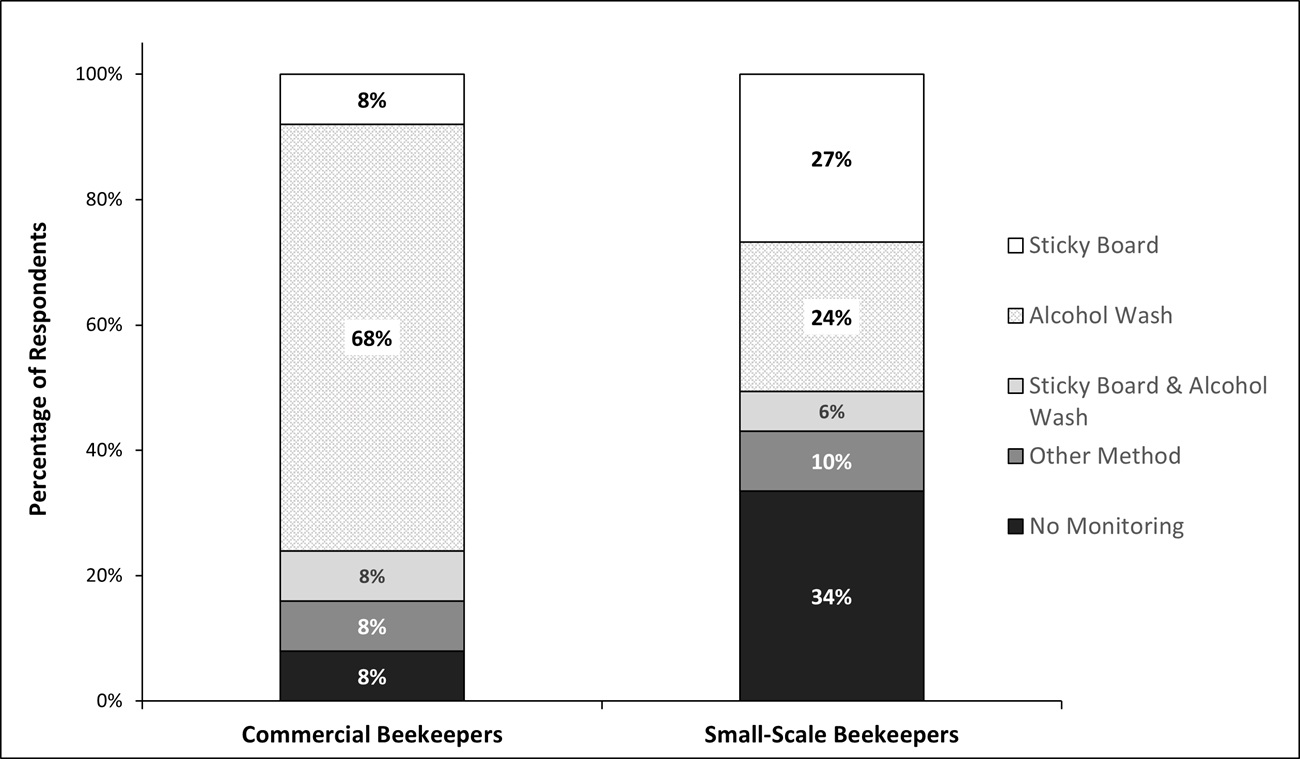
Accessible description of Figure 1
Proportion of beekeepers monitoring for varroa mites
Of the beekeepers who responded to the varroa mite monitoring question, 92% of commercial beekeepers and 66% of small-scale beekeepers stated they monitor for varroa mite infestation in their colonies. Several monitoring methods were used, the most common being either an alcohol wash or a sticky board (Figure 1).
Some beekeepers used more than 1 method to monitor for varroa mites. Of the beekeepers who responded to the varroa mite monitoring questions, when the response “other” was selected:
- 2% of beekeepers reported that they visually checked their colonies for varroa mites
- 7% used the “sugar shake” method
- 1% used the “CO2 roll” method
These methods are not officially recommended or recognized as effective, as visually checking for mites is not proven to yield usable information, and the sugar shake and CO2 roll methods can be unreliable and are not tied to established treatment thresholds for Ontario.
Most commercial beekeepers (92%), represented by this survey, are monitoring for varroa mites. This figure continues to rise, up from the 86% in 2022–2023 and 79% in 2021–2022. The number of commercial beekeepers who do not monitor for varroa mites decreased by 6% compared to the 2022–2023 survey. This positive trend must be balanced with other aspects of varroa mite monitoring, such as frequency of sampling.
By comparison, only 66% of small-scale beekeepers reported monitoring for varroa mites in 2023–2024, which is less than the 69% who reported monitoring for varroa mites in the previous survey year (2022–2023).
Concerns with lack of monitoring
Though the proportion of responding commercial beekeepers who sampled for varroa mites is increasing, it is alarming that 8% of commercial beekeepers and 34% of small-scale beekeepers reported no monitoring for varroa mites at all.
Assuming “other” methods (8% for commercial beekeepers and 10% for small-scale beekeepers) are insufficient for reliable monitoring brings the level of no or insufficient monitoring up in both beekeeper categories.
Almost half of small-scale beekeepers conduct insufficient monitoring or do not monitor at all, increasing the risk of varroa mites spreading to other nearby colonies. Given the significant threat varroa mites pose to the industry, recent high winter loss estimates may be linked to the lack of monitoring.
Importance of monitoring
Effective monitoring and management practices are essential to combat varroa mites:
- Monitoring, frequent sampling for varroa mites, and timely application of varroa mite treatments are crucial for managing this serious honey bee pest.
- Without proper varroa mite management, colonies are at a high risk of death and spreading varroa mites to other nearby colonies.
- Research has demonstrated that inadequate varroa mite control is the primary cause of winter mortality in honey bee colonies in Ontario.
footnote 2
Frequency of monitoring for varroa mites
A good proportion of commercial and small-scale beekeepers are sampling at least twice per season. As this is the bare minimum, it is encouraging to see that some beekeepers are sampling at least 3 times per year (Figure 2).
A more detailed analysis (Figure 3) of those beekeepers who sampled more than 3 times per year shows that monthly sampling was conducted by:
- 44% of commercial beekeepers
- 51% of small-scale beekeepers
Survey results show that there must be improvement in the frequency of monitoring for varroa mites in both categories of beekeepers. Sampling for varroa every month (in a proportion of colonies and bee yards) is required to manage this serious pest.
Monitoring frequently and after application of treatment, particularly as the beekeeping season progresses, is one of the most important management practices beekeepers can perform. This practice ensures timely application of varroa mite treatments and prevents damaging levels of varroa, especially in the bees going into winter.
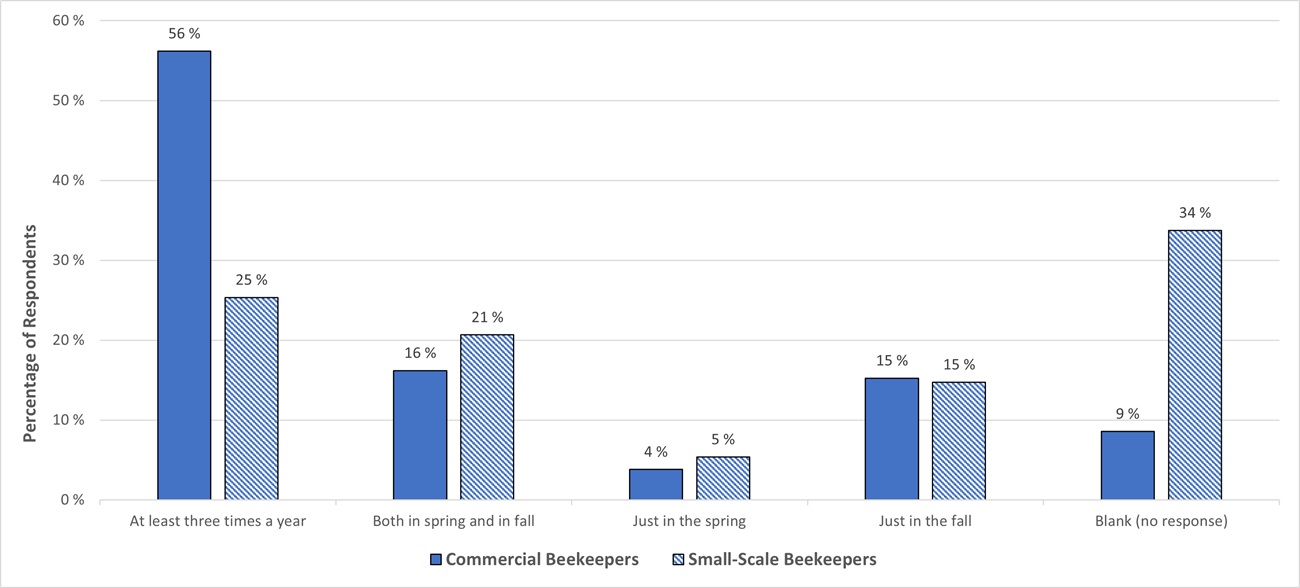
Accessible description of Figure 2
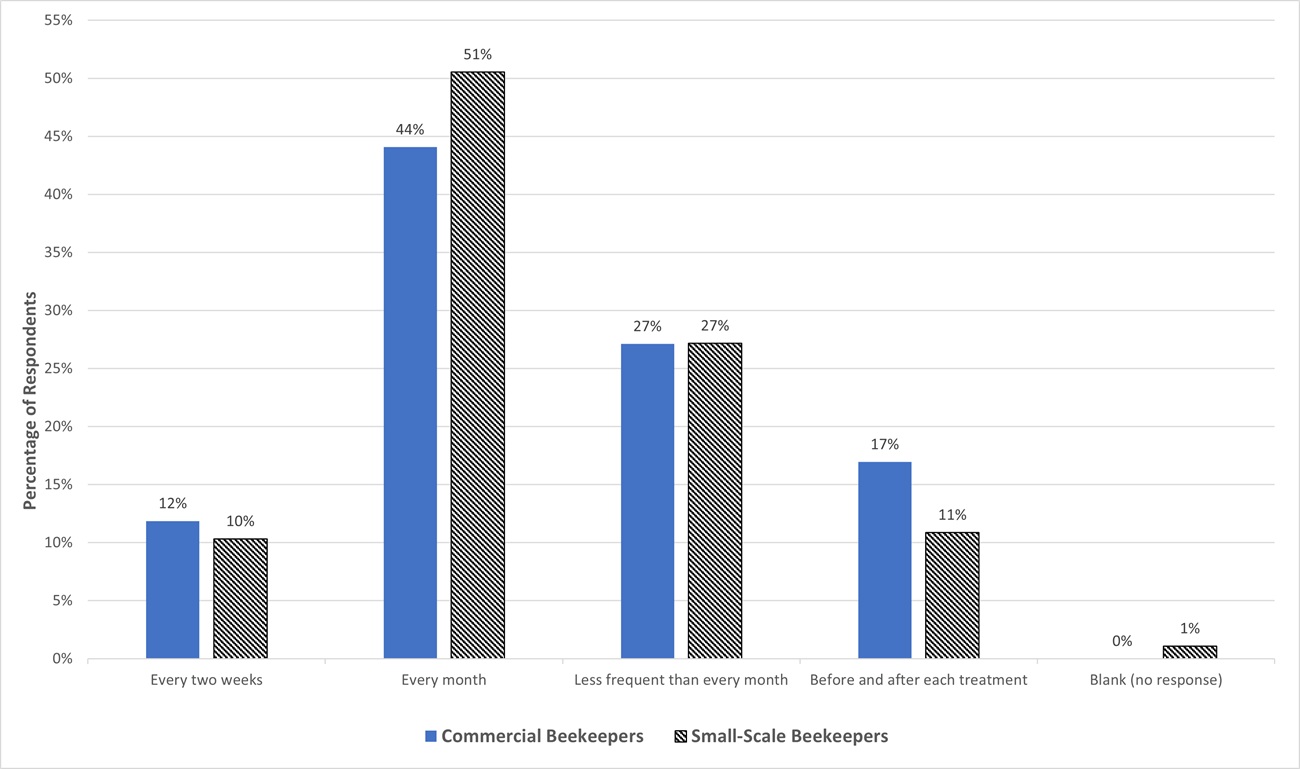
Accessible description of Figure 3
Treatments used to control varroa mites
Ontario beekeepers use a variety of treatment options to manage varroa mites (Table 5). The survey asked beekeepers to report their use of varroa mite treatment options during 3 periods in 2023. These periods are defined as:
- spring: from the end of winter to the start of the honey flow
- mid-season: from the start to the end of the honey flow
- late summer/fall: when the last supers were removed for honey production to when colonies were managed for winter
In spring of 2023, the most common chemical methods of varroa mite treatment reported by commercial beekeepers were use of Oxalic Acid (32%) and Apivar® (31%), while in late summer/fall of 2023 both oxalic acid (60%) and Apivar® (42%) were most commonly used. The most common method of spring varroa mite treatment reported by small-scale beekeepers was use of Apivar® (24%) and Formic Pro (22%), while in late summer/fall of 2023 oxalic acid (31%) and Apivar® (30%) were the most common treatments used.
| Varroa mite treatment (active ingredient) | Spring 2023 % of commercial beekeepers | Spring 2023 % of small-scale beekeepers | Mid-season 2023 % of commercial beekeepers | Mid-season 2023 % of small-scale beekeepers | Late summer/fall 2023 % of commercial beekeepers | Late summer/fall 2023 % of small-scale beekeepers |
|---|---|---|---|---|---|---|
| Apistan® (fluvalinate) | 4 | 5 | N/A | N/A | 4 | 5 |
| CheckMite+™ (coumaphos) | 0 | 0 | N/A | N/A | 0 | 0 |
| Apivar® (amitraz) | 31 | 24 | N/A | N/A | 42 | 30 |
| Thymovar (thymol) | 2 | 2 | N/A | N/A | 8 | 2 |
| ApiLifeVar (thymol and essential oils) | 0 | 1 | N/A | N/A | 3 | 1 |
| Bayvarol® (flumethrin) | 0 | 0 | N/A | N/A | 0 | 0 |
| 65% formic acid – 40 ml multiple application | 12 | 4 | N/A | N/A | 19 | 5 |
| 65% formic acid – 250 ml single application | 4 | 3 | N/A | N/A | 3 | 2 |
| Mite Away Quick Strips™ (formic acid) | 3 | 3 | 6 | 4 | 3 | 3 |
| Formic Pro (formic acid) | 18 | 22 | 31 | 24 | 14 | 18 |
| Oxalic Acid | 32 | 17 | N/A | N/A | 60 | 31 |
| Hopguard II (hop compounds) | 1 | 1 | 1 | 1 | 2 | 1 |
| Other | 8 | 2 | 13 | 7 | 3 | 0 |
| None | 15 | 24 | 42 | 54 | 4 | 8 |
The results showed that 15% of commercial beekeepers and 24% of small-scale beekeepers surveyed are not treating for varroa mites in the spring. This is concerning as spring is a very important time for controlling varroa mite populations to prevent damage and to manage the mite’s population growth at the onset of the beekeeping season (Figure 4). If a beekeeper does not treat in spring, it is unlikely that they will be able to control varroa mite levels for the rest of the season.
Similarly concerning is that 4% of commercial beekeepers and 8% of small-scale beekeepers did not use any treatment in late summer/fall. This is another key time to treat as varroa mite levels are peaking (Figure 4). Without reducing varroa mites leading up to winter, honey bee colonies are at high risk of mortality leading up to, during, or after winter.
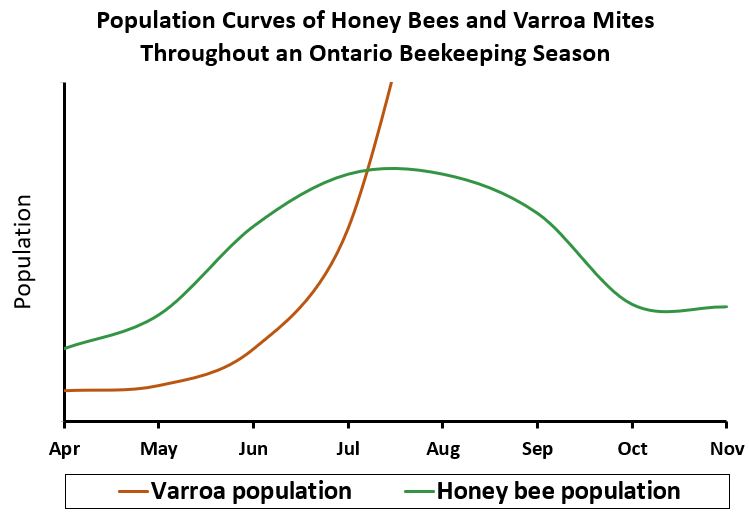
During the mid-season of 2023, a large proportion of commercial (42%) and small-scale beekeepers (54%) reported that they did not treat for varroa mites. For those beekeepers that did apply mid-season treatments, the most common treatment method used by both groups was Formic Pro.
The use of mid-season treatments has become an important part of the strategy to prevent varroa mite population growth and damage. The use of mid-season treatments may be new for many beekeepers in Ontario, but this approach is important to incorporate into seasonal management to stay ahead of varroa mite population growth. This becomes crucial as earlier springs can cause varroa levels to peak earlier than in previous years.
Some responses supplied in the “other” response option indicated the use of treatments mid-season that are not registered for use during a honey flow. These treatments might have been used by beekeepers who had removed their honey supers or were managing colonies not producing honey, such as nucleus colonies or pollination units. The data collected through this survey did not allow us to determine if mid-season treatments were being used according to label instructions.
The least commonly used treatments by both commercial and small-scale beekeepers were:
- CheckMite+™
- Bayvarol®
- ApiLifeVar
- Hopguard II or III
Varroa mites resistant to amitraz
It appears that Ontario beekeepers are rotating their miticides, which is an important strategy for delaying the onset of resistant populations of varroa mites. There are some indications that the industry is shifting away from its reliance on Apivar® as a control method for varroa mites. This shift may be related to concerns about the development of varroa mite resistance to amitraz, the active ingredient in Apivar®.
In fall 2023, the Ontario Apiary Program and the Ontario Beekeepers’ Association’s Technology Transfer Program conducted a small study to investigate amitraz resistance in Ontario. The results showed high efficacy (90% and above) in most of the samples collected. While the study could not conclude that there was established and wide-spread resistance to amitraz in varroa mite populations in Ontario, the possibility cannot be dismissed as every beekeeping operation in Ontario was not tested.
Varroa mites in Ontario have established resistance (or reduced efficacy) to other compounds, including:
- coumaphos
- fluvalinate
- flumethrin
Apivar® (amitraz) still appears to be an effective option and more efficacious than some other methods of varroa control. Beekeepers must be mindful that any treatment option used against varroa has the potential of resistance or lower efficacy due to environmental conditions where treatments are temperature dependent. Beekeepers may also want to consider using a flash treatment with an organic acid before or after the full use period of Apivar®. As per label instructions, beekeepers should not combine Apivar® with another treatment as this may degrade the Apivar® and/or impact the bees in ways the manufacturer had not tested for. As amitraz resistance has been documented in varroa mite populations in the United States and other parts of Canada (some prairie provinces), it is important to monitor its status in Ontario.
There are numerous, legally registered options for varroa control that are available to Ontario beekeepers. Each of these treatments have their own advantages and disadvantages and beekeepers must make their own decision on what to use balancing:
- efficacy
- temperature thresholds
- cost
- handling time
- application methods
Treatments should not be viewed through the lens of “what’s the best treatment”. Beekeeping operations may have to consider changing some of their established production or labor practices to adopt new ways of managing varroa mites. Ultimately, beekeepers in Ontario must rely on multiple types of treatments, used in rotation, and likely multiple applications of treatments throughout the beekeeping season, guided by regular sampling for varroa mites and anticipating varroa growth (Figure 4).
Looking ahead, new compounds or treatment methods will be needed for varroa mite control to ensure there is a robust set of options available to beekeepers and to offer the opportunity to rotate treatments. This would allow beekeepers to continue to incorporate effective integrated pest management practices in their beekeeping operation and manage varroa mites for the survival of their colonies. Unfortunately, the identification, testing and legal registration of new compounds and treatments can take many years.
Beekeeper management practices for varroa mites
The survey results highlight the need for further education and training for beekeepers to improve their integrated pest management practices. Both commercial and small-scale beekeepers need to enhance their monitoring for varroa mites, especially the frequency of sampling. This is a key practice to assess colony health and to improve the survival of colonies going into the winter.
Every beekeeper should regularly monitor a proportion of their honey bee colonies and bee yards for varroa mites including after treatments. It is not enough for beekeepers to treat their colonies without knowing their varroa mite levels. Beekeepers who rely solely on treatment without monitoring are at high risk of losing a large proportion of their colonies to varroa mites.
Finally, beekeepers should treat at key times of the season, likely a minimum of 3 times.
Without monitoring and treating at key times, Ontario beekeepers will continue to lose a high proportion of their colonies, undermining the sustainability of Ontario’s beekeeping industry.
Nosema spp. (N. apis and N. ceranae)
In the spring of 2023, 86% of commercial and 82% of small-scale survey respondents indicated that they did not apply nosema treatment. In the fall of 2023, 77% of commercial and 68% of small-scale survey respondents did not treat for nosema (Table 6).
Nosema is a disease that can delay the development of honey bee colonies in spring and reduce the lifespan of individual honey bees. It has not been identified as a factor in colony mortality over winter
| Nosema treatment | Spring 2023 % of commercial beekeepers | Spring 2023 % of small-scale beekeepers | Fall 2023 % of commercial beekeepers | Fall 2023 % of small-scale beekeepers |
|---|---|---|---|---|
| Fumagillin | 5 | 5 | 7 | 5 |
| Other | 3 | 1 | 3 | 0 |
| None | 86 | 82 | 77 | 68 |
American foulbrood (Paenibacillus larvae)
Less than half of commercial beekeepers who responded to this survey question treated for American foulbrood (AFB) during spring 2023 (46%) and during fall 2023 (38%) with oxytetracycline. By comparison, 16% of small-scale beekeepers reported treating for AFB in the spring and in the fall (Table 7).
While the prophylactic use of antibiotics can protect bees from the spread of the vegetative stage of AFB, it does not address the spore stage of AFB. Therefore, beekeepers must incorporate frequent examination of colonies for the symptoms of AFB and use biosecurity practices to mitigate the potential spread of AFB spores within and between operations.
| American foulbrood treatment | Spring 2023 % of commercial beekeepers | Spring 2023 % of small-scale beekeepers | Fall 2023 % of commercial beekeepers | Fall 2023 % of small-scale beekeepers |
|---|---|---|---|---|
| Oxytetracycline | 46 | 16 | 38 | 16 |
| Tylosin | 1 | 0 | 1 | 0 |
| Lincomycin | 0 | 0 | 0 | 0 |
| Other | 0 | 0 | 0 | 0 |
| None | 50 | 62 | 57 | 61 |
Ontario’s overwinter mortality
The Canadian Association of Professional Apiculturists compiles overwinter mortality data provided by each province and publishes an annual report on national honey bee colony losses. Figure 5 compares Ontario’s overwinter mortality levels to that of Canada’s. The 2024 estimate for commercial beekeepers in Ontario (50.4%) was approximately 16% more than the estimation for bee loss averaged between all of Canada (34.6%).
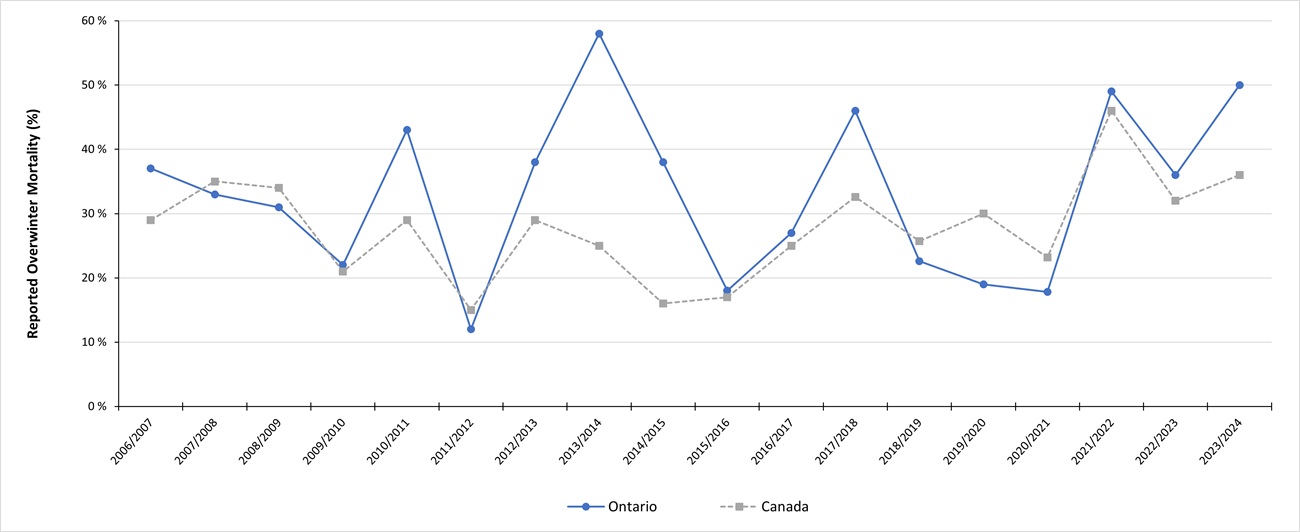
Accessible description of Figure 5
Accessible image descriptions
Figure 1. Type of varroa mite monitoring method used by commercial and small-scale beekeepers in 2023. Survey respondents could select more than 1 method of monitoring when completing the survey.
Figure 1 shows the type of varroa mite monitoring method used by commercial and small-scale beekeepers in 2023. 8% of commercial beekeepers reported using the sticky board method, 68% used the alcohol wash method, 8% used both sticky board and alcohol wash, 8% used other methods, and 8% reported no monitoring for varroa mites. 27% of small-scale beekeepers reported using the sticky board method, 24% used the alcohol wash method, 6% used both sticky board and alcohol wash, 10% used other methods, and 34% reported no monitoring for varroa mites.
Figure 2. Frequency of varroa mite monitoring by commercial and small-scale beekeepers in 2023.
Figure 2 shows the frequency of varroa mite monitoring by commercial and small-scale beekeepers in 2023:
Commercial beekeepers:
- 56% at least 3 times a year
- 16% both in spring and in fall
- 4% just in the spring
- 15% just in the fall
- 9% did not respond to this question
Small-scale beekeepers:
- 25% at least 3 times a year
- 21% both in spring and in fall
- 5% just in the spring
- 15% just in the fall
- 34% did not respond to this question
Figure 3. Frequency of varroa mite monitoring by commercial and small-scale beekeepers in 2023 who reported monitoring at least 3 times a year. Survey respondents could select more than 1 answer.
Figure 3 shows the frequency of varroa mite monitoring by commercial and small-scale beekeepers in 2023 who reported monitoring at least 3 times a year.
Commercial beekeepers:
- 12% every 2 weeks
- 44% every month
- 27% less frequent than every month
- 17% before and after each treatment
- 0% did not respond to this question
Small-scale beekeepers:
- 10% every 2 weeks
- 51% every month
- 27% less frequent than every month
- 11% before and after each treatment
- 1% did not respond to this question
Figure 5. Overwinter mortality (%) reported by commercial beekeepers in Ontario (blue) and Canada (grey) from 2006-2007 to 2023-2024.
Figure 5 shows the percentage of overwinter mortality reported by beekeepers in both Ontario and Canada from 2007 to 2024. The reported overwinter mortality in Ontario and Canada (respectively) was:
- 2007: 37% and 29%
- 2008: 33% and 35%
- 2009: 31% and 34%
- 2010: 22% and 21%
- 2011: 43% and 29%
- 2012: 12% and 15%
- 2013: 38% and 29%
- 2014: 58% and 25%
- 2015: 38% and 16%
- 2016: 18% and 17%
- 2017: 27% and 25%
- 2018: 46% and 33%
- 2019: 23% and 26%
- 2020: 19% and 30%
- 2021: 18% and 23%
- 2022: 49% and 46%
- 2023: 36% and 32%
- 2024: 50% and 35%
Footnotes
- footnote[1] Back to paragraph Some beekeepers who reported "other" provided multiple suspected causes of death in their response. Each beekeeper who reported "other" is only counted once.
- footnote[2] Back to paragraph Guzmán-Novoa, E., L. Eccles, Y. Calvete, J. McGowan, P. Kelly and A. Correa-Benítez (2010). Varroa destructor is the main culprit for the death and reduced populations of overwintered honey bee (Apis mellifera) colonies in Ontario, Canada. Apidologie 41(4): 443-450.
- footnote[3] Back to paragraph Emsen, B., E. Guzman-Novoa, M. M. Hamiduzzaman, L. Eccles, B. Lacey, R. A. Ruiz-Pérez and M. Nasr (2016). Higher prevalence and levels of Nosema ceranae than Nosema apis infections in Canadian honey bee colonies. Parasitol Res 115(1): 175-181.
- footnote[4] Back to paragraph Emsen, B., A. De la Mora, B. Lacey, L. Eccles, P. G. Kelly, C. A. Medina-Flores, T. Petukhova, N. Morfin and E. Guzman-Novoa (2020). Seasonality of Nosema ceranae infections and their relationship with honey bee populations, food stores, and survivorship in a North American region" Veterinary Sciences 7(3): 131.